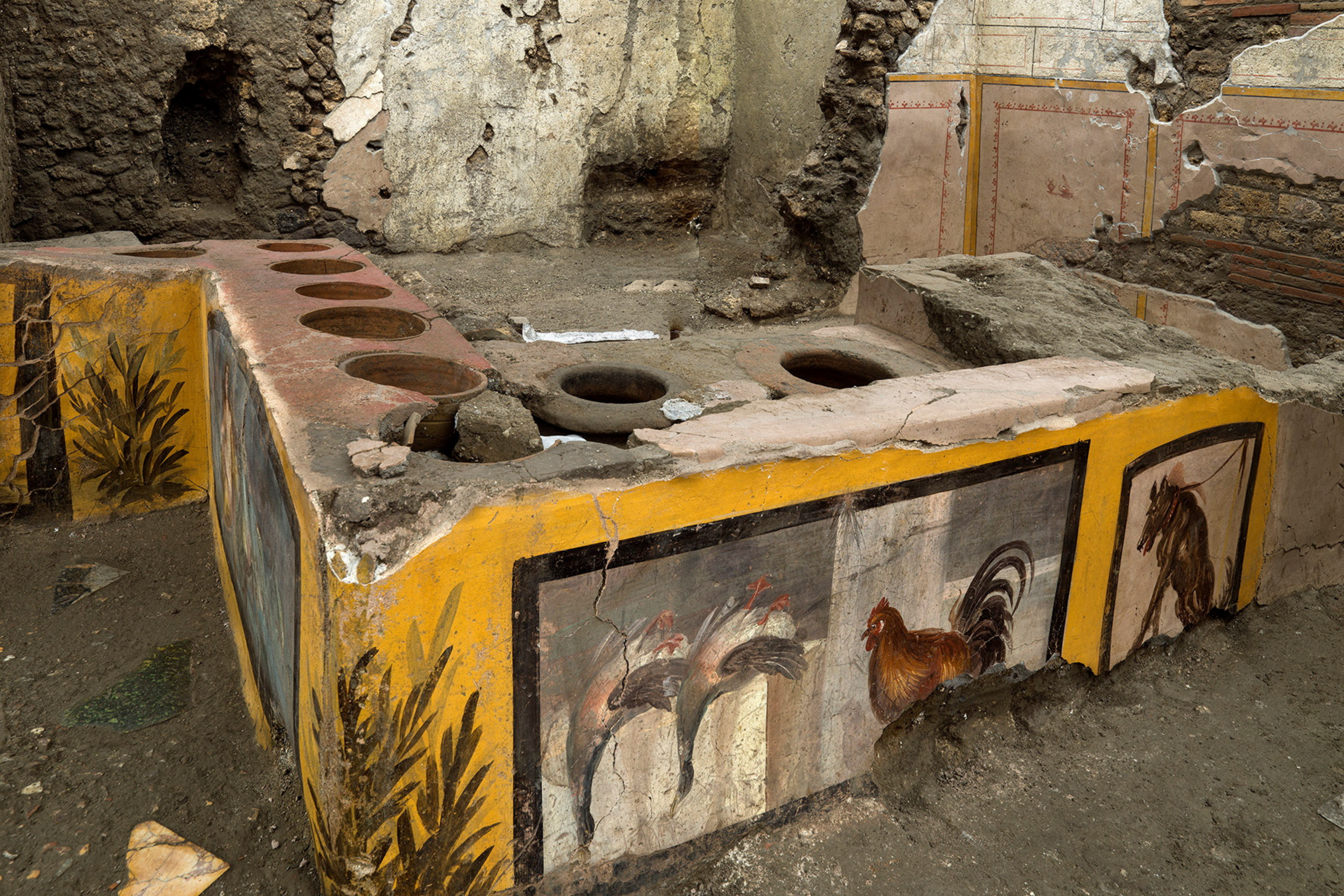
The ancient Roman city of Pompeii was once a flourishing travel destination, decimated by the eruption of Mount Vesuvius in 79 A.D. Preserved beneath a thick layer of ash for almost 1,600 years, it wasn’t until the mid-1700s that a group of explorers stumbled upon the city frozen in time. Three hundred years later, archaeologists have made another extraordinary find, unearthing a hot food and drinks shop that served as street food for Roman tourists. The discovery, which included trace amounts of food left in the shop’s jars, is a testament to the preservation of the ancient, once-bustling city.
What Happened to Pompeii?
Several thousand years ago, the ancient Roman city of Pompeii was a thriving city home to between 10,000 and 20,000 people. Located 14 miles southeast of present-day Naples, the Italian town was a flourishing resort for some of Rome’s wealthiest vacationers and their servants. Elegant homes and lavish villas lined the paved streets, while grand public buildings dominated the landscape. Tourists and locals bustled between open-air squares, taverns and cafes, and bathhouses.
Volcanic activity was not uncommon for the townspeople. The city of Pompeii is located about 10 miles from Mount Vesuvius, an active volcano that has erupted for thousands of years. Just sixteen years before the famous eruption, a massive earthquake rumbled through the area, signaling what was to come. In August of 79 A.D., the volcano finally erupted, propelling lava, rocks, and hot ash 21 miles into the air for all the town’s residents to see. The ash rose so high that writer Pliny the Younger could watch the eruption from across the bay. He later wrote a letter recalling, “Darkness fell, not the dark of a moonless or cloudy night, but as if the lamp had been put out in a dark room.”
As the scorching-hot lava cooled in the air, it drifted back to Earth as fine-grained ash and small chunks of rock. While most of the villagers had plenty of time to pack their belongings, some Pompeiians refused to leave the town. As more ash fell, air conditions became worse, and people and buildings collapsed. A second surge of hot, poisonous gas traveled down the side of the mountain, devouring anything in its wake. By the second day of volcanic activity, the molten lava and falling debris had killed 2,000 townspeople. The eruption decimated the entire city, leaving it buried in ash.
Ancient City, New Discoveries
Pompeii remained preserved beneath a thick layer of ash for over 1,600 years, protected against harsh weather and those who might vandalize or destroy the city. It wasn’t until 1748 that a group of explorers began digging, astonished to find a village frozen in time. Since its discovery, archaeologists have excavated hundreds of buildings, from colorful shops and houses to an immense palaestra, or outdoor theater. Everyday objects, household goods, and even skeletons have been unearthed, positioned just as they were almost 2,000 years ago. In addition, some archaeologists have been lucky enough to stumble upon jars of preserved fruit and bread left in villagers’ ovens.
In December of 2020, archaeologists discovered the extraordinary preservation of a termopolium, Latin for a hot food and drink counter; the equivalent of today’s street food and fast food chains. Within the shop, archaeologists found jars containing traces of fish, snails, and beef, suggesting that the street vendor used and sold many foods to prepare meals. They also found cooking utensils and a bronze drinking bowl. In addition, the front counter remained covered in brightly colored frescoes or paintings done in watercolor, which depicted the types of food sold–from chicken to duck. “This is an extraordinary find. It’s the first time we are excavating an entire termopolium,” Massimo Osssana, director of the Pompeii archaeological park, said.
The find is an exciting addition to archaeologists’ 300-year-long excavation efforts. Although archaeologists have unearthed two-thirds of the town as of 2020, they remain just as fascinated as they were in 1754. Moreover, Pompeii continues to be one of Italy’s largest tourist attractions, impressing all those who visit its haunting and timeless streets. It is perhaps no mystery why Pompeii is a UNESCO world heritage site, recognized for its cultural, historical, and universal value.
0 of 4 Questions completed
Questions:
You have already completed the quiz before. Hence you can not start it again.
Quiz is loading…
You must sign in or sign up to start the quiz.
You must first complete the following:
0 of 4 Questions answered correctly
Your time:
Time has elapsed
You have reached 0 of 0 point(s), (0)
Earned Point(s): 0 of 0, (0)
0 Essay(s) Pending (Possible Point(s): 0)
Select the sentence that BEST summarizes the article.
CCSS.ELA-Literacy.CCRA.R.2
According to the article, WHY were archaeologists able to uncover so many objects from the ancient city?
CCSS.ELA-Literacy.CCRA.R.1
According to the article, which of the following is NOT an effect the Mount Vesuvius eruption had on Pompeiians?
CCSS.ELA-Literacy.CCRA.R.3
Read the following sentence from “Ancient City, New Discoveries“:
“Since its discovery, archaeologists have excavated hundreds of buildings, from colorful shops and houses to an immense palaestra, or outdoor theater.”
Which word or words could replace “excavated” without changing the meaning of the sentence?
CCSS.ELA-Literacy.CCRA.R.4
0 of 1 Questions completed
Questions:
You have already completed the quiz before. Hence you can not start it again.
Quiz is loading…
You must sign in or sign up to start the quiz.
You must first complete the following:
0 of 1 Questions answered correctly
Your time:
Time has elapsed
You have reached 0 of 0 point(s), (0)
Earned Point(s): 0 of 0, (0)
0 Essay(s) Pending (Possible Point(s): 0)
Choose an event from the text. Write a short narrative to describe the event using details.
This response will be reviewed and graded after submission.

Copyright 2021 – NexGen News. All Rights Reserved.